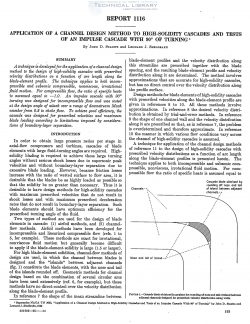naca-report-1116
- Version
- 201 Downloads
- 1.91 MB File Size
- 1 File Count
- October 27, 2016 Create Date
- October 27, 2016 Last Updated
National Advisory Committee for Aeronautics, Report - Application of Channel Design Method to High Solidity Cascades and Tests of an Impulse Cascade with 90° of Turning

A technique is developed for the application of a channel design
method to the design of highrsolidity cascades with prescribed
velocity distributions as a junction of arc length along the
blade-element profile. The technique applies to both incom-
pressible and subsonic compressible, nonviscous, irrotational
fluid motion. For compressible flow, the ratio of specific heats
is assumed equal to —1.0. An impulse cascade with 90°
turning was designed for incompressible flow and was tested
at the design angle of attack over a range of downstream Mach
number from 0.2 to choke flow. To achieve good efiiciency,’the
cascade was designed for prescribed velocities and maccimnm
blade loading according to limitations imposed by considera-
tions of boundary-layer separation.
In order to obtain large pressure ratios per stage in
axial—flow compressors and turbines, cascades of blade
elements with large fluid-turning angles are required. High-
solidity blading is required to achieve these large turning
angles without serious shock losses due to supersonic peak
velocities and without boundary-layer separation due to
excessive blade loading. However, because friction losses
increase with the ratio of wetted surface to flow area, it is
desirable that the blades be as highly loaded as possible so
that the solidity be no greater than necessary. Thus it is
desirable to have design methods for high-solidity cascades
with maximum prescribed velocities that do not result in
shock losses and with maximum prescribed deceleration
rates that do not result in boundary-layer separation. Such
blade elements should have optimum efliciency for the
prescribed turning angle of the fluid.
Two types of method are used for the design of blade
elements in cascade: (1) airfoil methods, and (2) channel-
flow methods. Airfoil methods have been developed _for
incompressible and linearized compressible flow (refs. 1 to
5, for example). These methods are exact for irrotational,
nonviscous fluid motion but generally become difficult
to apply if the blade-element solidity is large (1.5 or larger).
| File | Action |
|---|---|
| naca-report-1116 Application of Channel Design Method to High Solidity Cascades and Tests of an Impulse Cascade with 90° of Turning.pdf | Download |

Comment On This Post